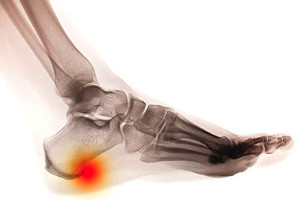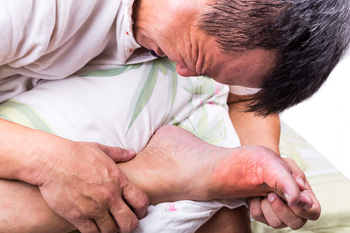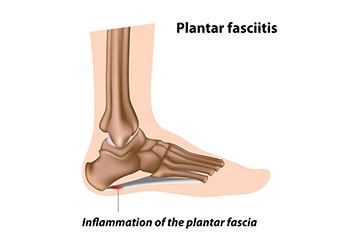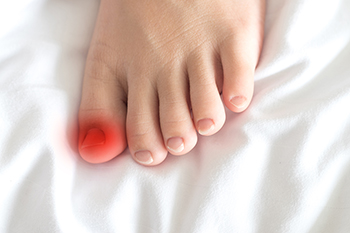Connect With Us
Blog
Items filtered by date: November 2022
Can Heel Spurs Be Prevented?

Many people have heel pain and show no other symptoms. This can indicate a heel spur has developed, and treatment is often sought for relief. A heel spur is defined as a bony growth that gradually forms on the bottom of the heel, and can come from excessive pressure the heels endure from being overweight, or if the plantar fascia becomes damaged. Wearing shoes that do not fit correctly may cause a heel spur to develop, in addition to having an abnormal foot structure. There are specific groups of people who may be prone to developing a heel spur. These can include runners, elderly people, diabetic patients, or people who have frequent gout attacks. People who have pain with a heel spur often notice there is tenderness surrounding the heel, and the affected foot and ankle may become swollen. Additionally, there may be sharp heel pain after rising in the morning. Effective prevention methods may consist of stretching the feet regularly, wearing insoles that can provide support, and maintaining a healthy weight. If you feel you have a heel spur, it is strongly urged that you consult with a podiatrist who can properly treat this condition.
Heel spurs can be incredibly painful and sometimes may make you unable to participate in physical activities. To get medical care for your heel spurs, contact Dr. James D. McAlexander from Gig Harbor Foot and Ankle Clinic. Our doctor will do everything possible to treat your condition.
Heels Spurs
Heel spurs are formed by calcium deposits on the back of the foot where the heel is. This can also be caused by small fragments of bone breaking off one section of the foot, attaching onto the back of the foot. Heel spurs can also be bone growth on the back of the foot and may grow in the direction of the arch of the foot.
Older individuals usually suffer from heel spurs and pain sometimes intensifies with age. One of the main condition's spurs are related to is plantar fasciitis.
Pain
The pain associated with spurs is often because of weight placed on the feet. When someone is walking, their entire weight is concentrated on the feet. Bone spurs then have the tendency to affect other bones and tissues around the foot. As the pain continues, the feet will become tender and sensitive over time.
Treatments
There are many ways to treat heel spurs. If one is suffering from heel spurs in conjunction with pain, there are several methods for healing. Medication, surgery, and herbal care are some options.
If you have any questions feel free to contact our office located in Gig Harbor, WA . We offer the latest in diagnostic and treatment technology to meet your needs.
Gout Often Begins in the Big Toe

People who have pain in the joints of the big toe may be experiencing a foot condition known as gout. It is caused by excess uric acid in the blood and can come from various reasons. These include genetic factors or eating foods that have elevated amounts of purines. In certain people, purines convert into uric acid which forms crystals in the joints of the toes, generally beginning with the big toe. This can cause considerable pain and discomfort, and it can be difficult for patients to walk when they are affected by gout. Some of the foods that fall into this group of high purine levels include shellfish, red meat, alcohol, and drinks that are made with large amounts of sugar. The pain that gout attacks can cause will often guide patients into developing healthier lifestyle habits. These consist of drinking plenty of water daily, gently performing exercise routines and stretches, and limiting specific types of foods. If you have had gout attacks, it is strongly suggested that you are under the care of a podiatrist who can provide you with expert medical attention for prompt relief.
Gout is a painful condition that can be treated. If you are seeking treatment, contact Dr. James D. McAlexander from Gig Harbor Foot and Ankle Clinic. Our doctor will treat your foot and ankle needs.
What Is Gout?
Gout is a form of arthritis that is characterized by sudden, severe attacks of pain, redness, and tenderness in the joints. The condition usually affects the joint at the base of the big toe. A gout attack can occur at any random time, such as the middle of the night while you are asleep.
Symptoms
- Intense Joint Pain - Usually around the large joint of your big toe, and it most severe within the first four to twelve hours
- Lingering Discomfort - Joint discomfort may last from a few days to a few weeks
- Inflammation and Redness -Affected joints may become swollen, tender, warm and red
- Limited Range of Motion - May experience a decrease in joint mobility
Risk Factors
- Genetics - If family members have gout, you’re more likely to have it
- Medications - Diuretic medications can raise uric acid levels
- Gender/Age - Gout is more common in men until the age of 60. It is believed that estrogen protects women until that point
- Diet - Eating red meat and shellfish increases your risk
- Alcohol - Having more than two alcoholic drinks per day increases your risk
- Obesity - Obese people are at a higher risk for gout
Prior to visiting your podiatrist to receive treatment for gout, there are a few things you should do beforehand. If you have gout you should write down your symptoms--including when they started and how often you experience them, important medical information you may have, and any questions you may have. Writing down these three things will help your podiatrist in assessing your specific situation so that he or she may provide the best route of treatment for you.
If you have any questions, please feel free to contact our office located in Gig Harbor, WA . We offer the newest diagnostic and treatment technologies for all your foot care needs.
Symptoms and Causes of Plantar Fasciitis

Plantar fasciitis is easily the most common cause of heel pain complaints and is characterized by stabbing pain under the heel. It is the result of inflammation of a band of tissue that runs along the sole of the foot. This tissue, known as the plantar fascia, connects the toes to the heel and supports the arch. Plantar fasciitis is generally thought to be a repetitive use injury that causes tiny tears in the tissue that then become inflamed, and ultimately painful. It is common in runners, athletes, and people who are obese. Teachers, restaurant servers, or anyone who spends a long time standing are often at risk. In addition, athletes who repeatedly run or walk on hard surfaces often develop plantar fasciitis. Symptoms include extreme pain upon arising in the morning, which gradually wears off as activity increases, only to re-emerge at the end of the day. A number of stretches and exercises, along with better cushioning in footwear, often reduce the symptoms of plantar fasciitis. For more information on treatment opportunities, please consult a podiatrist.
Plantar fasciitis is a common foot condition that is often caused by a strain injury. If you are experiencing heel pain or symptoms of plantar fasciitis, contact Dr. James D. McAlexander from Gig Harbor Foot and Ankle Clinic. Our doctor can provide the care you need to keep you pain-free and on your feet.
What Is Plantar Fasciitis?
Plantar fasciitis is one of the most common causes of heel pain. The plantar fascia is a ligament that connects your heel to the front of your foot. When this ligament becomes inflamed, plantar fasciitis is the result. If you have plantar fasciitis you will have a stabbing pain that usually occurs with your first steps in the morning. As the day progresses and you walk around more, this pain will start to disappear, but it will return after long periods of standing or sitting.
What Causes Plantar Fasciitis?
- Excessive running
- Having high arches in your feet
- Other foot issues such as flat feet
- Pregnancy (due to the sudden weight gain)
- Being on your feet very often
There are some risk factors that may make you more likely to develop plantar fasciitis compared to others. The condition most commonly affects adults between the ages of 40 and 60. It also tends to affect people who are obese because the extra pounds result in extra stress being placed on the plantar fascia.
Prevention
- Take good care of your feet – Wear shoes that have good arch support and heel cushioning.
- Maintain a healthy weight
- If you are a runner, alternate running with other sports that won’t cause heel pain
There are a variety of treatment options available for plantar fasciitis along with the pain that accompanies it. Additionally, physical therapy is a very important component in the treatment process. It is important that you meet with your podiatrist to determine which treatment option is best for you.
If you have any questions, please feel free to contact our office located in Gig Harbor, WA . We offer the newest diagnostic and treatment technologies for all your foot care needs.
Understanding Ingrown Toenails

Most people misunderstand the seriousness of an ingrown toenail unless they experience one. Ingrown toenails frequently affect the big toe and result from the nail growing into the skin, instead of over it. Pain and discomfort are often the beginning signs that an ingrown toenail has developed. When left untreated, it may become infected, bleed, and there may be discharge or pus. An ingrown toenail can be caused by trimming the toenails incorrectly, wearing shoes that are too tight, and genetic reasons. Occasionally, the toe will feel better when soaked in warm water and a cotton swab can be used to gently push the skin away from the nail. This is a temporary fix for mild relief. A permanent solution can be found at a podiatrist's office. People who have recurring ingrown toenails often seek the expertise of this type of doctor, who can effectively treat it. An infected ingrown toenail may qualify for surgery, and it is suggested that you contact a podiatrist to determine the best course of treatment for you.
Ingrown toenails can become painful if they are not treated properly. For more information about ingrown toenails, contact Dr. James D. McAlexander of Gig Harbor Foot and Ankle Clinic. Our doctor can provide the care you need to keep you pain-free and on your feet.
Ingrown Toenails
Ingrown toenails occur when a toenail grows sideways into the bed of the nail, causing pain, swelling, and possibly infection.
Causes
- Bacterial infections
- Improper nail cutting such as cutting it too short or not straight across
- Trauma to the toe, such as stubbing, which causes the nail to grow back irregularly
- Ill-fitting shoes that bunch the toes too close together
- Genetic predisposition
Prevention
Because ingrown toenails are not something found outside of shoe-wearing cultures, going barefoot as often as possible will decrease the likeliness of developing ingrown toenails. Wearing proper fitting shoes and using proper cutting techniques will also help decrease your risk of developing ingrown toenails.
Treatment
Ingrown toenails are a very treatable foot condition. In minor cases, soaking the affected area in salt or antibacterial soaps will not only help with the ingrown nail itself, but also help prevent any infections from occurring. In more severe cases, surgery is an option. In either case, speaking to your podiatrist about this condition will help you get a better understanding of specific treatment options that are right for you.
If you have any questions please feel free to contact our office located in Gig Harbor, WA . We offer the newest diagnostic and treatment technologies for all your foot and ankle needs.
Possible Benefits of Walking Barefoot

There are several benefits that can occur when parents encourage their children to walk barefoot. These can include improvements in balance, walking, and range of motion. Additionally, the joints and muscles in the feet can become stronger, as a result of the toes gripping the floor. Research has indicated that the nervous system is stimulated when a child walks barefoot, and pressure points are used to send messages to various parts of the body. Children often become more aware of their surroundings when they walk barefoot outside. Walking on different surfaces such as grass, sand, leaves, and concrete can help the child to become more sensitive to nature. Their motor skills may be improved, and it may be easier to jump and balance during playtime activities. It is advised that sunscreen is applied to the child’s feet, and as a precaution against getting a sunburn, shoes may need to be worn outside on a particularly sunny day. If you would like more information about the benefits of having your child walk barefoot, please ask a podiatrist who can help you with the information you are seeking.
The health of a child’s feet is vital to their overall well-being. If you have any questions regarding foot health, contact Dr. James D. McAlexander of Gig Harbor Foot and Ankle Clinic. Our doctor can provide the care you need to keep you pain-free and on your feet.
Tips for Keeping Children's Feet Healthy
- Make sure their shoes fit properly
- Look for any signs of in-toeing or out-toeing
- Check to see if they have Clubfoot (condition that affects your child’s foot and ankle, twisting the heel and toes inward) which is one of the most common nonmajor birth defects.
- Lightly cover your baby’s feet (Tight covers may keep your baby from moving their feet freely, and could prevent normal development)
- Allow your toddler to go shoeless (Shoes can be restricting for a young child’s foot)
- Cut toenails straight across to avoid ingrown toenails
- Keep your child’s foot clean and dry
- Cover cuts and scrapes. Wash any scratches with soap and water and cover them with a bandage until they’ve healed.
If you have any questions, please feel free to contact our office located in Gig Harbor, WA . We offer the newest diagnostic and treatment technologies for all your foot care needs.
Blog Archives
- December 2024
- November 2024
- October 2024
- September 2024
- April 2023
- March 2023
- February 2023
- January 2023
- December 2022
- November 2022
- October 2022
- September 2022
- August 2022
- July 2022
- June 2022
- May 2022
- April 2022
- March 2022
- February 2022
- January 2022
- December 2021
- November 2021
- October 2021
- September 2021
- August 2021
- July 2021
- June 2021
- May 2021
- April 2021
- March 2021
- February 2021
- January 2021
- December 2020
- November 2020
- October 2020
- September 2020
- August 2020
- July 2020
- June 2020
- May 2020
- April 2020
- March 2020
- February 2020
- January 2020
- December 2019
- November 2019
- October 2019
- September 2019
- August 2019
- July 2019
- June 2019
- May 2019
- April 2019
- March 2019
- February 2019
- January 2019
- December 2018
- November 2018
- October 2018
- September 2018
- August 2018
- July 2018
- June 2018
- May 2018
- April 2018
- March 2018
- February 2018
- January 2018
- December 2017
- November 2017
- October 2017

